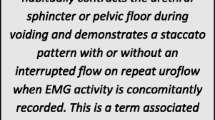Abstract
Introduction and hypothesis
The objective of this study is to evaluate the effect of transient catheterization on uroflow parameters.
Methods
Consenting women (ages 18–90) provided an uninstrumented uroflow pre- and post-indicated in urodynamic procedures. Voided volume, Qmax, and Qave were recorded for both uninstrumented uroflows. Uroflow curves were classified as “normal” or “abnormal.” Pre- and post-urodynamic uroflow data were compared.
Results
Thirty-five patients were included in the study. There was a statistically significant decrease in Qave from the pre- to the post-urodynamic uroflows from 14.71 to 10.55 ml/s (p = 0.012). Additionally, 28.6% of uroflow tracing patterns changed from “normal” to “abnormal,” whereas only one (2.9%) changed from “abnormal” to “normal” (p = 0.031).
Conclusions
This study showed a degradative effect of transient catheterization on uroflow parameters, suggesting that catheterization may cause more than simply a passive obstructive effect. Urethral stimulation due to catheterization may perturb detrusor urethral function, altering voiding and possibly filling performance.


Similar content being viewed by others
References
Klausner AP, Galea J, Vapnek JM (2002) Effect of catheter size on urodynamic assessment of bladder outlet obstruction. Urology 60(5):875–880
Trumbeckas D et al (2006) Influence of catheter on urinary flow during urodynamic pressure-flow study in men with symptomatic benign prostatic hyperplasia. Medicina (Kaunas) 42(1):15–21
Ryall RL, Marshall VR (1982) The effect of a urethral catheter on the measurement of maximum urinary flow rate. J Urol 128(2):429–432
Scaldazza CV, Morosetti C (2005) Effect of different sized transurethral catheters on pressure-flow studies in women with lower urinary tract symptoms. Urol Int 75(1):21–25
Groutz A, Blaivas JG, Sassone AM (2000) Detrusor pressure uroflowmetry studies in women: effect of a 7Fr transurethral catheter. J Urol 164(1):109–114
Issa MM et al (2003) The effect of urethral instrumentation on uroflowmetry. BJU Int 92(4):426–428
Jung SY et al (1999) Urethral afferent nerve activity affects the micturition reflex; implication for the relationship between stress incontinence and detrusor instability. J Urol 162(1):204–212
Abrams P et al (2003) The standardisation of terminology in lower urinary tract function: report from the standardisation sub-committee of the International Continence Society. Urology 61(1):37–49
Feneley MR et al (1996) Reproducibility of uroflow measurement: experience during a double-blind, placebo-controlled study of doxazosin in benign prostatic hyperplasia. Urology 47(5):658–663
Griffiths DJ (1991) Assessment of detrusor contraction strength or contractility. Neurourol Urodyn 10(1):1–18
Griffiths DJ, Constantinou CE, van Mastrigt R (1986) Urinary bladder function and its control in healthy females. Am J Physiol 251(2 Pt 2):R225–R230
Lose G, Thunedborg P, Jorgensen L, Colstrup H (1986) A comparison of spontaneous and intubated urinary flow in female patients. Neurourol Urodyn 5:1–4
Abelli L et al (1991) Mechanical irritation induces neurogenic inflammation in the rat urethra. J Urol 146(6):1624–1626
Peng CW et al (2008) Role of pudendal afferents in voiding efficiency in the rat. Am J Physiol Regul Integr Comp Physiol 294(2):R660–R672
Lose G, Jorgensen L (1989) Effect of urethral catheterisation on urethral sphincter EMG and pressure profile. Neurourol Urodyn 8:473–480
Conflicts of interest
None.
Author information
Authors and Affiliations
Corresponding author
Rights and permissions
About this article
Cite this article
Suskind, A.M., Smith, P.P. Evidence of a functional effect of transient transurethral catheterization on micturition in women. Int Urogynecol J 23, 1245–1248 (2012). https://doi.org/10.1007/s00192-011-1646-2
Received:
Accepted:
Published:
Issue Date:
DOI: https://doi.org/10.1007/s00192-011-1646-2




